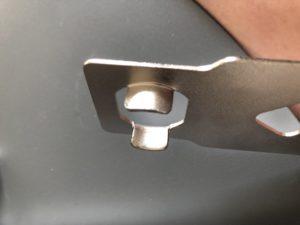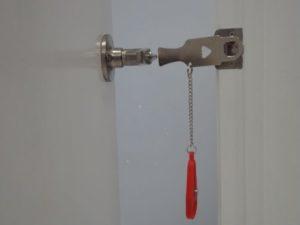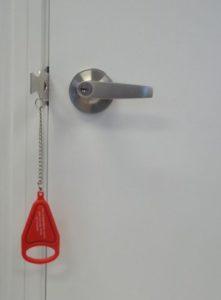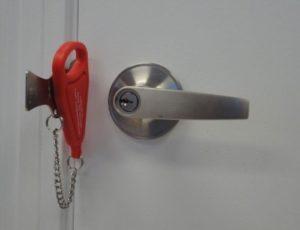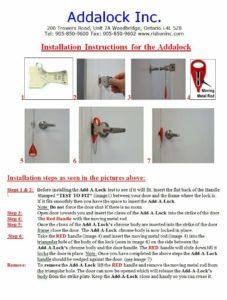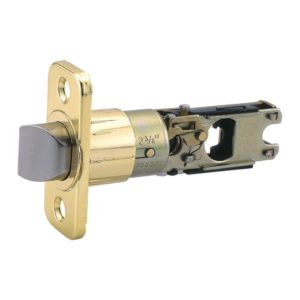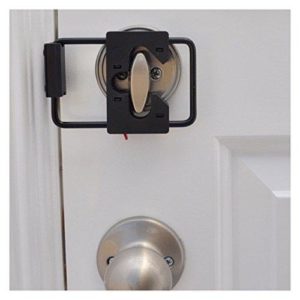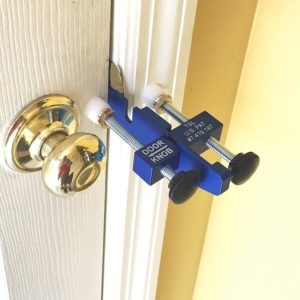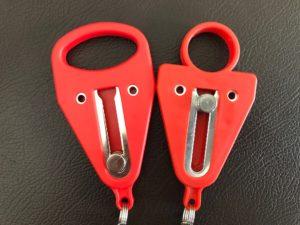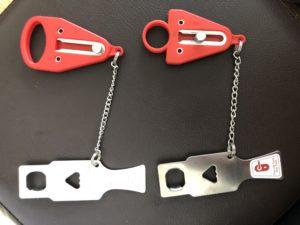Introduction
I travel a lot, sometimes alone. I have left hotels almost immediately after checking in because I felt unsafe with the accommodations. Sometimes a hotel will assign a room to two people by mistake, and one person walks in on the other using a valid key (I’ve seen this happen). RFID “hotel master keys” exist.
After #summercamp this year, where hotels were doing “room checks” and people (including me) were experiencing strange unidentified visitors, a reply from @8aconB1t to my thread included a recommendation to try a device that is “portable door lock that installs in seconds without any tools required.”
There was, of course, also a recommendation for a low-budget way to make an emergency lock out of a metal fork, which works in a very similar way, but requires you to break the fork. Interesting, nonetheless. Thank you, @analogm1.
A “portable door lock” (PDL) device is intended to provide extra security for you while you are behind a locked door. PDLs prevent the door from being pushed open, even if it has been unlocked, to help provide “additional safety, security, and privacy” while you are in, for example, your hotel room. PDLs do not provide any security while you are away because they can’t be installed from the outside.
The descriptions for PDLs provide possible use cases, including:
- AirBNB or short term rental
- Travel
- At home
- Apartment living
- Students
- School Lock Down (terrifying to think!)
- Preventing a toddler or small child from leaving the house unsupervised
Article note: Click on small images for the original, larger image to see detail.
Parts of a Doorknob
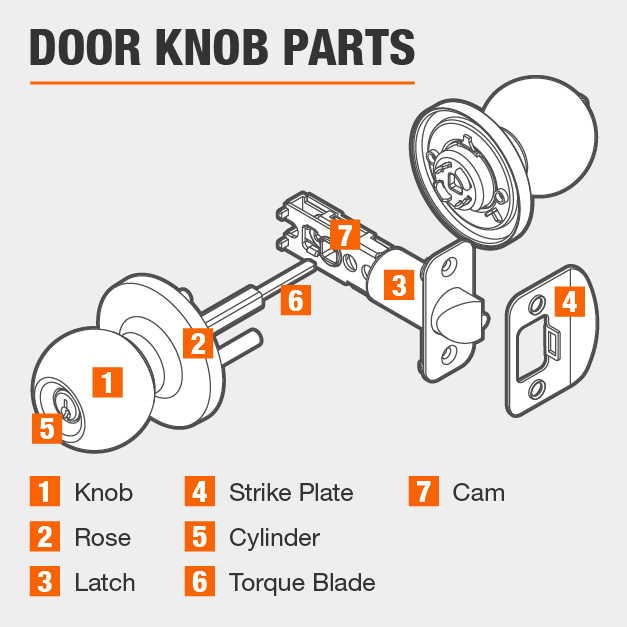
The idea behind a PDL is to prevent the latch bolt from exiting the strike. The PDL mechanism consists of a metal body with “claws” that are inserted into the strike of the door frame. It does no damage to the door frame and doesn’t really “grip”, it just “sits” in between the strike and the latch bolt and forms a ring around the strike hole for the Latch Bolt. The door is then closed over the PDL.
The Red Handle is attached via a Chain. The Chain is merely a convenience feature to keep both pieces together when it’s not in use.
The Red Handle is the piece that actually blocks the door from opening. It has a sliding metal Cylinder attached to a Track. The Cylinder is placed into the triangular hole on the metal body and the cylinder slides to the top of the Track. The door is now prevented from opening, even if it is unlocked.
To undo the mechanism, you simply pull up on the Red Handle, turn the door knob, and un-insert the metal body from the strike hole.
NOTES:
These PDLs work regardless of whether the knob is on the right or left side of the door.
These PDLs do NOT work on doors that open outwards.
Two of the PDLs reviewed in this article ONLY WORK with standard “tubular latch bolts” like this:
The Candidates
There were a few different options for PDLs on Amazon that I decided not to order because they seemed a bit ‘hokey’, for example:
The options on Amazon for this style of portable door lock (PDL), which made the most sense and seemed the most convenient to me, were at the time of writing (2018-08-24):
1) The “Addalock” ($21.95 USD with PRIME shipping)

The “Addalock”
2) The “MasterBolt Travel Door Lock Security” ($19.95 with PRIME shipping)

MasterBolt Travel Door Lock Security
Added 2018-09-14:
3) The Calslock Portable Door and Travel Lock ($19.95 with PRIME Shipping)
This is an all-metal (brass plated steel) device that is designed to fit doors that have any type of door latch bolt (not just the standard tubular style). I purchased this only after traveling with the Addalock and running into problems with it in hotels, apartments, etc.
Comparison
I purchased one of each, unclear on how they were different or which was better, and decided to write this review. I figured I could use one at home and keep one in my luggage for travel, or return the others if they sucked and buy a second one of whichever was better 🙂
The Addalock
As the more expensive option, I wanted to figure out why The “Addalock” was worth $2 more.
The case is definitely nicer. It features a hook-and-loop strap, and thick vinyl.

Addalock case
Addalock’s Red Handle (pictured left, below) has a larger grip (the finger hole at the top), which is better for for big fingers or using two smaller fingers for removing the Red Handle when disabling the PDL.
The Addalock also has a larger Red Handle than the MasterBolt, which presumably could indicate that it is stronger and harder to break. They are both one piece, but the Addalock is “thicker” and doesn’t seem as breakable as the MasterBolt.
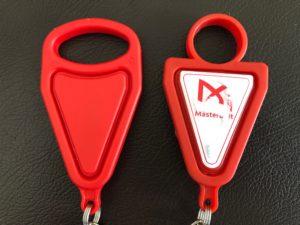
Red Handles compared – Addalock (left), MasterLock (right)
Addalock’s Track is also slightly longer than the MasterBolt, which could help prevent circumvention.
The MasterBolt
The MasterBolt has a velvety drawstring pouch that is not form fitting. It feels nice but it’s also sort of cheap. Addalock is a winner here.
The MasterBolt is 0.2oz lighter than the Addalock, which IMHO is not a great thing when you’re dealing with physical security. Heavier in this case means there is more plastic on the Red Handle, which we see in the finger hole design, making the Addalock seem more durable.
The MasterBolt does include instructions right on the device, which may be considered a feature.
The Calslock (Added to review 2018-09-14)
The Calslock works with virtually any door, including non-tubular lock bolts.
Why?
The problem with #1 and #2 is not exactly the bolt itself, but the hole size of the strikeplate. Since #1 and #2 are molded for the tubular bolt to go through them, anything that isn’t that size won’t fit so the bolt wont be able to enter the strikeplate and the door won’t lock. You would then be completely reliant on the PDL, if it even fit in the strikeplate.
This is a “high-security” lock bolt setup, where there are usually 3 or 5 cylinders that go into the strikeplate:

The Calslock WOULD work with this, because of the strikeplate on the left not conforming to the size of the bolts. If the strikeplate holes were the same size as the bolts themselves, this device would not work. But as it is just a big cutout hole, The Calslock device could likely be used with this strikeplate. It would depend how the wall had been drilled out!
The #1 and #2 PDLs DO NOT work with “scissor latch” style door which has a “deadlatch“. Only the Calslock works with this type of door
There is a special type of door latch called a “scissor latch” that is designed to make doors close more quietly. This is something that buildings like offices, hotels, apartments like, so they install these
The “deadlatch” plunger (aka “deadlock plunger”) helps prevent bypass methods like “the credit card trick” we’ve all seen in movies or the much easier Sparrows Hall Pass, which requires a bit of coordination and strength but can open a tubular lock in seconds. If you’re interested in this at all, check out this thread on Twitter. FYI the deadlatch is the 4th protruding piece of metal from the top or the 2nd piece of metal up from the screw in the following photo:
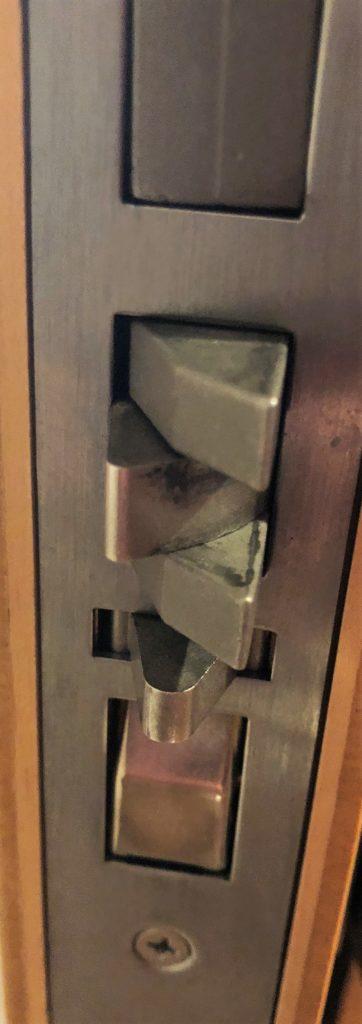
Scissor latch door bolt – The #1 and #2 PDLs I reviewed DO NOT WORK (The latch is too large). Only the Calslock PDL (#3) works with this type of door!
To install the Calslock, you insert the bent end into the strikeplate on the wall side. You then squeeze the brass sliding piece to move the bumper as far away from the strikeplate as possible. This helps when closing the door, as the door may hit the little bumper piece. Continue holding the device while you close the door. You then squeeze the brass piece to release its grip on the teeth and push it forward, towards the door. When it is snug, it is locked from the inside.
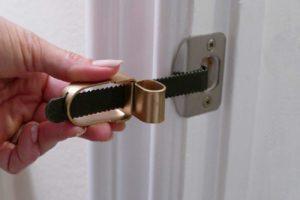
Calslock Installed
Te Calslock is a little more difficult than option #1 and #2 to insert into the strikeplate and close the door. It does not include a handy carrying case of any kind. I have not tried to take it in carry-on luggage yet (could this be seen as a weapon even if it isn’t a blade?)
Summary
The similarities between the two devices are the size, overall design, and weight. If you hold the metal body pieces over one another, they line up exactly. They work identically, with identical overall instructions for use, and both fit the doors I tried in my home. There is a slight difference in the chains, as well, but the chain is not really part of the security of the device, it is just to keep the pieces together when not installed.
The primary differences are the “finger hole” size, the very slight difference in the length of the moving metal rod, and the included carrying case.
In my opinion, the winner for standard tubular doors (particularly internal doors) is the Addalock. The more solid Red Handle design, the slightly longer moving metal rod, and the better carrying case give it the edge over the MasterBolt in terms of durability and convenience. You can purchase the Addalock direct from Amazon at this link: https://amzn.to/2NbYCYr
PDL CONCLUSION
Best Budget/Overall:
The Calslock is the OVERALL winner for PDLs in terms of size, cost, and ease of use. It is just more universal. It’s not cute and doesn’t have a little chain or a heart-shaped hole, but it works with the locks I see most often. You can keep one at home and one in your suitcase. You can purchase the Calslock direct from Amazon at this link: https://amzn.to/2QuIPWG
Best If Money Is No Object:
If you have the money, the “Travelers Security Lock – Portable Door Lock” is more effective by distributing the force used to push open the door. It “uses Newton’s 3rd law of physics and applies any force taken and distributes it amongst the lock and door frame”. It’s a little more tricky to setup but the added security could be worth the effort. You can purchase the Travelers Security Lock direct from Amazon at this link: https://amzn.to/2Km8Ppa
Door Jams
A door jam like this (with or without an alarm) may be a more universal option, though a large gap under the door could allow an intruder to “push” the device away with a coat hanger or similar.


